Navigation
Pandas in the Wild Filmed by WWF Camera Traps Offer Rare Glimpse of Habitat and Species Conservation in China
On 22 May 2013 the WWF released dozens of photographs and video footage of endangered species captured by camera traps in the mountainous giant panda reserves in China, marking this year’s International Day for Biological Diversity. With the footage, taken since 2011, WWF conservation officers have gained a better understanding of the identification of animal traces and areas of their activities, the study of the impact of human activities on the species and management of nature reserves, according to Jiang.
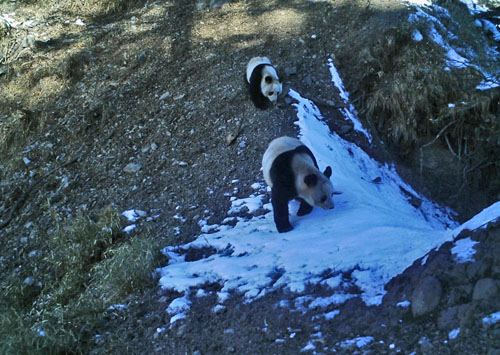 Giant Panda (Ailuropoda melanoleuca) captured in Wang Lang NR, Sichuan. WWF / Peking University: © WWF China/Wang Lang NR/Peking University / WWF-Canon
Giant Panda (Ailuropoda melanoleuca) captured in Wang Lang NR, Sichuan. WWF / Peking University: © WWF China/Wang Lang NR/Peking University / WWF-Canon
On 22 May 2013 the WWF released dozens of photographs and video footage of endangered species captured by camera traps in the mountainous giant panda reserves in China, marking this year’s International Day for Biological Diversity.
The images and footage, rarely seen before, showcase an array of endangered species in their remote habitats in southwestern Sichuan Province, including giant panda, red panda, Tibetan stump-tailed macaque and leopard cat.
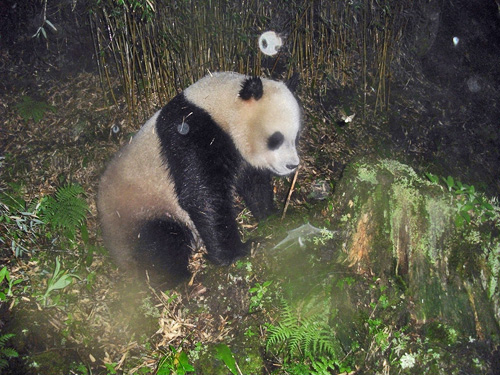 Giant Panda (Ailuropoda melanoleuca) captured in Wang Lang NR, Sichuan. WWF / Peking University: © WWF China/Wang Lang NR/Peking University / WWF-Canon
Giant Panda (Ailuropoda melanoleuca) captured in Wang Lang NR, Sichuan. WWF / Peking University: © WWF China/Wang Lang NR/Peking University / WWF-Canon
“The multimedia materials are obtained under circumstances where there was little external disturbance and, therefore, they truly reflect the conditions of those species in the wild,” said Jiang Zeyin, species programme officer at WWF-China.
With the footage, WWF conservation officers have gained a better understanding of the identification of animal traces and areas of their activities, the study of the impact of human activities on the species and management of nature reserves, according to Jiang.
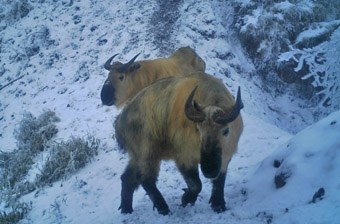 Takin (Budorcas taxicolor), An Zi He NR, China WWF / Peking University: © WWF China/An Zi He NR/Peking University / WWF-CanonThe materials were filmed since 2011 by more than 100 infra-red camera traps set up in six nature reserves by WWF and its partners from the local forestry authority as part of the monitoring effort under the giant panda conservation programme.
Takin (Budorcas taxicolor), An Zi He NR, China WWF / Peking University: © WWF China/An Zi He NR/Peking University / WWF-CanonThe materials were filmed since 2011 by more than 100 infra-red camera traps set up in six nature reserves by WWF and its partners from the local forestry authority as part of the monitoring effort under the giant panda conservation programme.
“The images demonstrate that through the conservation of the giant panda, a flagship umbrella species, we can also protect other threatened wildlife from the same habitat and preserve biological diversity,” said Fan Zhiyong, director of WWF species programme in China. It is a tried method in WWF’s biodiversity conservation and the reason why WWF would underscore the value of protecting flagship species, he said.
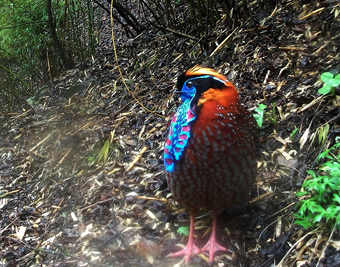 Temminck's tragopan (Tragopan temminckii) captured in Wang Lang NR, Sichuan. WWF / Peking University: © WWF China/Wang Lang NR/Peking University / WWF-CanonChina has more than 6,500 species of vertebrates representing 14 percent of the global total, making it one of the 12 globally recognized “mega-biodiversity” countries.
Temminck's tragopan (Tragopan temminckii) captured in Wang Lang NR, Sichuan. WWF / Peking University: © WWF China/Wang Lang NR/Peking University / WWF-CanonChina has more than 6,500 species of vertebrates representing 14 percent of the global total, making it one of the 12 globally recognized “mega-biodiversity” countries.
However, the population of more than 10 flagship and keystone species in China, which include Amur tigers, musk deer and the Yangtze finless porpoise, have undergone a marked decline that was particularly severe between the 1960s and 1980s.
“The overall biodiversity in China is in decline despite partial improvement in some places. The main threat has been the habitat loss and fragmentation due to invasive human activities,” said Fan.
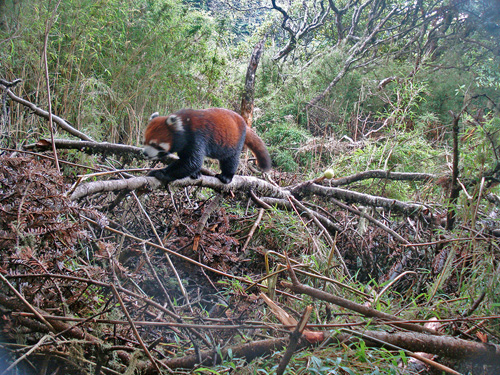 Red Panda (Ailurus fulgens) captured in Shen Guo Zhuang NR, Sichuan. WWF / Peking University: © WWF China/Shen Guo Zhuang NR/Peking University / WWF-Canon
Red Panda (Ailurus fulgens) captured in Shen Guo Zhuang NR, Sichuan. WWF / Peking University: © WWF China/Shen Guo Zhuang NR/Peking University / WWF-Canon
“Large-scale planning and implementation aimed at establishing a network of habitats should always be considered,” said Fan.
This news and the pictures are from the WWW, 22 May 2013
About WWF
WWF is one of the world's largest and most respected independent conservation organizations, with over 5 million supporters and a global network active in over 100 countries. WWF's mission is to stop the degradation of the Earth's natural environment and to build a future in which humans live in harmony with nature, by conserving the world's biological diversity, ensuring that the use of renewable natural resources is sustainable, and promoting the reduction of pollution and wasteful consumption.
Search
Latest articles
Agriculture
- World Water Week: Healthy ecosystems essential to human health: from coronavirus to malnutrition Online session Wednesday 24 August 17:00-18:20
- World Water Week: Healthy ecosystems essential to human health: from coronavirus to malnutrition Online session Wednesday 24 August 17:00-18:20
Air Pollution
- "Water and Sanitation-Related Diseases and the Changing Environment: Challenges, Interventions, and Preventive Measures" Volume 2 Is Now Available
- Global Innovation Exchange Co-Created by Horizon International, USAID, Bill and Melinda Gates Foundation and Others
Biodiversity
- It is time for international mobilization against climate change
- World Water Week: Healthy ecosystems essential to human health: from coronavirus to malnutrition Online session Wednesday 24 August 17:00-18:20
Desertification
- World Water Week: Healthy ecosystems essential to human health: from coronavirus to malnutrition Online session Wednesday 24 August 17:00-18:20
- UN Food Systems Summit Receives Over 1,200 Ideas to Help Meet Sustainable Development Goals
Endangered Species
- Mangrove Action Project Collaborates to Restore and Preserve Mangrove Ecosystems
- Coral Research in Palau offers a “Glimmer of Hope”
Energy
- Global Innovation Exchange Co-Created by Horizon International, USAID, Bill and Melinda Gates Foundation and Others
- Wildlife Preservation in Southeast Nova Scotia
Exhibits
- Global Innovation Exchange Co-Created by Horizon International, USAID, Bill and Melinda Gates Foundation and Others
- Coral Reefs
Forests
- NASA Satellites Reveal Major Shifts in Global Freshwater Updated June 2020
- Global Innovation Exchange Co-Created by Horizon International, USAID, Bill and Melinda Gates Foundation and Others
Global Climate Change
- It is time for international mobilization against climate change
- It is time for international mobilization against climate change
Global Health
- World Water Week: Healthy ecosystems essential to human health: from coronavirus to malnutrition Online session Wednesday 24 August 17:00-18:20
- More than 400 schoolgirls, family and teachers rescued from Afghanistan by small coalition
Industry
- "Water and Sanitation-Related Diseases and the Changing Environment: Challenges, Interventions, and Preventive Measures" Volume 2 Is Now Available
- Global Innovation Exchange Co-Created by Horizon International, USAID, Bill and Melinda Gates Foundation and Others
Natural Disaster Relief
- STOP ATTACKS ON HEALTH CARE IN UKRAINE
- Global Innovation Exchange Co-Created by Horizon International, USAID, Bill and Melinda Gates Foundation and Others
News and Special Reports
- World Water Week: Healthy ecosystems essential to human health: from coronavirus to malnutrition Online session Wednesday 24 August 17:00-18:20
- STOP ATTACKS ON HEALTH CARE IN UKRAINE
Oceans, Coral Reefs
- World Water Week: Healthy ecosystems essential to human health: from coronavirus to malnutrition Online session Wednesday 24 August 17:00-18:20
- Mangrove Action Project Collaborates to Restore and Preserve Mangrove Ecosystems
Pollution
- Zakaria Ouedraogo of Burkina Faso Produces Film “Nzoue Fiyen: Water Not Drinkable”
- "Water and Sanitation-Related Diseases and the Changing Environment: Challenges, Interventions, and Preventive Measures" Volume 2 Is Now Available
Population
- "Water and Sanitation-Related Diseases and the Changing Environment: Challenges, Interventions, and Preventive Measures" Volume 2 Is Now Available
- "Water and Sanitation-Related Diseases and the Changing Environment: Challenges, Interventions, and Preventive Measures" Volume 2 Is Now Available
Public Health
- Honouring the visionary behind India’s sanitation revolution
- Honouring the visionary behind India’s sanitation revolution
Rivers
- World Water Week: Healthy ecosystems essential to human health: from coronavirus to malnutrition Online session Wednesday 24 August 17:00-18:20
- Mangrove Action Project Collaborates to Restore and Preserve Mangrove Ecosystems
Sanitation
- Honouring the visionary behind India’s sanitation revolution
- Honouring the visionary behind India’s sanitation revolution
Toxic Chemicals
- "Water and Sanitation-Related Diseases and the Changing Environment: Challenges, Interventions, and Preventive Measures" Volume 2 Is Now Available
- Actions to Prevent Polluted Drinking Water in the United States
Transportation
- "Water and Sanitation-Related Diseases and the Changing Environment: Challenges, Interventions, and Preventive Measures" Volume 2 Is Now Available
- Urbanization Provides Opportunities for Transition to a Green Economy, Says New Report
Waste Management
- Honouring the visionary behind India’s sanitation revolution
- Honouring the visionary behind India’s sanitation revolution
Water
- Honouring the visionary behind India’s sanitation revolution
- Honouring the visionary behind India’s sanitation revolution
Water and Sanitation
- Honouring the visionary behind India’s sanitation revolution
- Honouring the visionary behind India’s sanitation revolution

